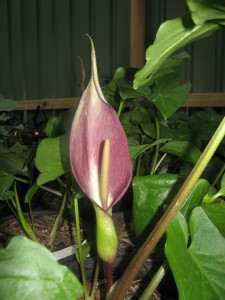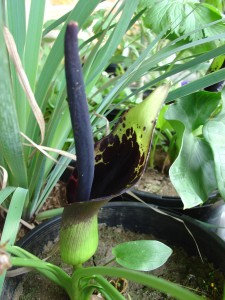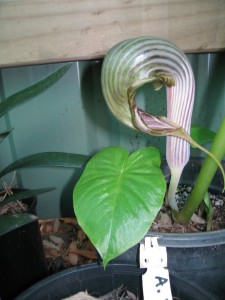 Are in the family ARACEAE. Their main feature is their floral structure which is made up of a central spadix which is the inflorescence that is wrapped around by the spathe which is often hood shaped.
Are in the family ARACEAE. Their main feature is their floral structure which is made up of a central spadix which is the inflorescence that is wrapped around by the spathe which is often hood shaped.
Aroid habitat includes everything from terrestrial, to alpine, bog and woodland as well as water plants. They come from all over the world.
Some are common garden plants like Arum lilies while others are rarely seen . They often have very attractive foliage and often attractive if occasionally foul smelling flowers.
Many adapt to harsh conditions by being deciduous during at least part of the year. Tropical aroids are generally deciduous during winter while Mediterranean ones are mostly deciduous in summer when they expect no rain to fall.

 For those gardeners with an intense interest in the endless variations of form and habit that plants present us with, aroids are a real source of enjoyment. The leaves alone are always interesting and the flowers never fail to surprise.
For those gardeners with an intense interest in the endless variations of form and habit that plants present us with, aroids are a real source of enjoyment. The leaves alone are always interesting and the flowers never fail to surprise.
A warning, some aroid flowers have rather disgusting odors. They might smell like dung, rotting meat or a smelly bog- but they have grown to use other pollinators than bees so they use a different attractant! Usually the odor is strongest on the first day of opening and the flowers always make up for it.
Most aroids grow in plant habitats that provide them with some shelter like bogs, woodlands etc. For this reason and especially in Australias’ climate, they seem to prefer part shade and a rich but well drained soil with protection from the hardest frost and the hottest summer winds.
To see more information on aroids visit the home of the International Aroid Society at- www.aroid.org

